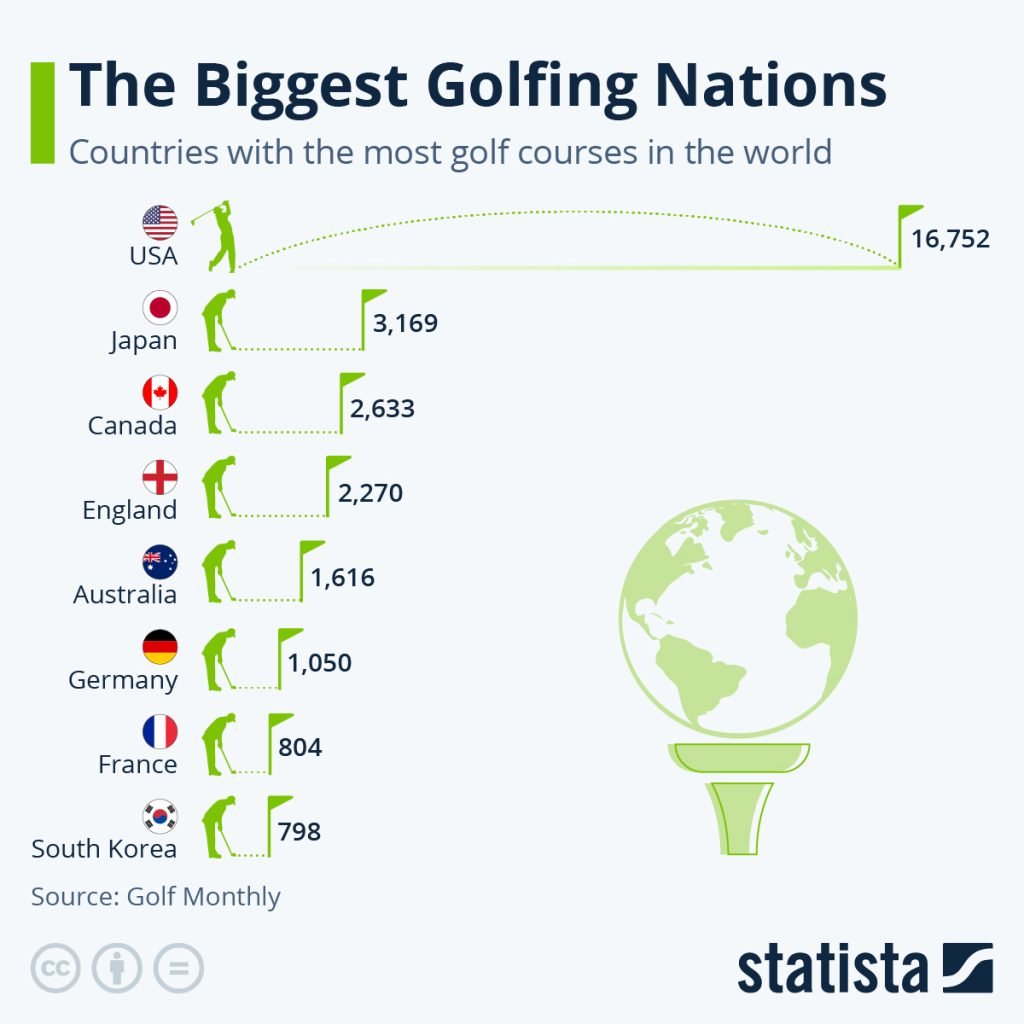Exploring the Expanse: how many golf courses in the world
Golf is a popular sport played by millions of people worldwide, and the number of golf courses globally reflects its widespread appeal and popularity. But just how many golf courses are there in the world? Let’s explore the facts and figures surrounding this question.
When it comes to the total number of golf courses in the world, it’s difficult to pinpoint an exact figure as the count can vary. However, it is estimated that there are over 38,000 golf courses worldwide, according to a study conducted by the National Golf Foundation. This includes both standard and executive courses spread across different continents.
The distribution of golf courses varies across continents, with some regions having a higher concentration than others. Factors such as popularity and demand for golf, availability of land, and economic considerations play a significant role in influencing the number of golf courses in a particular region.
The United States leads the way with the highest number of golf courses, followed by Japan, Canada, England, and Australia. These countries boast a long-standing golfing tradition and have developed a large number of courses to cater to the enthusiastic golfing community.
Trends and growth in the golf course industry are also worth mentioning. There has been a rise in emerging golfing destinations, with countries such as China, South Korea, and the United Arab Emirates investing in the development of world-class golf resorts and courses. sustainability and environmental practices have become increasingly important in the golf course industry, with efforts being made to reduce water usage, protect natural habitats, and adopt eco-friendly practices.
Key takeaway:
- The total number of golf courses in the world is substantial: With golf being a popular sport globally, there are numerous golf courses spread across continents, offering leisure and professional opportunities.
- Factors such as popularity, land availability, and economic factors influence the number of golf courses: The demand for golf, suitable land availability, and economic conditions play crucial roles in determining the number of golf courses in different regions around the world.
- Top countries with the highest number of golf courses: The United States, Japan, Canada, England, and Australia are among the countries with the highest number of golf courses, showcasing the popularity and widespread presence of the sport.
- Trends and growth in the golf course industry: The industry is witnessing emerging golfing destinations, providing new opportunities for enthusiasts. Additionally, sustainability and environmental practices are gaining importance, emphasizing the need for responsible development in the golf course industry.
What is the Total Number of Golf Courses in the World?
There are many golf courses around the world, catering to the passion and love for the sport. The number of golf courses globally is continually growing, providing more opportunities for enthusiasts to play the game they love.
North America has the highest number of golf courses globally, with a staggering 16,052 courses. Europe follows closely behind with 8,841 courses, while Asia boasts 7,681 courses of its own. Australia, South America, and Africa also have a significant number of courses, with 1,758, 1,354, and 840 respectively.
It’s important to note that Antarctica currently does not have any golf courses. However, with the continuous rise in popularity of the sport, who knows what the future holds?
Golf courses are influenced by various factors such as popularity and demand, availability of land, and economic considerations. Countries like the United States, Japan, Canada, England, and Australia have established themselves as leaders in the golfing world, with their high number of courses.
More Info:
- https://www.golfmonthly.com/courses/how-many-golf-courses-are-there-in-the-world-182153
- https://www.golflux.com/countries-have-the-most-golf-courses-in-the-world/
How Many Golf Courses are There in Each Continent?

To determine how many golf courses are there in each continent, we can analyze the available data. The table below provides a breakdown of the number of golf courses in each continent based on the most recent information:
| Continent | Number of Golf Courses |
|---|---|
| Africa | 1,443 |
| Asia | 12,535 |
| Europe | 21,115 |
| North America | 18,505 |
| Oceania | 6,739 |
| South America | 4,297 |
As of the latest data, Africa has 1,443 golf courses, while Asia has the highest number of golf courses with 12,535. Europe follows closely behind with 21,115 golf courses. North America has a total of 18,505 golf courses, while Oceania has 6,739. Lastly, South America has 4,297 golf courses.
It’s important to note that these numbers are subject to change, as new golf courses may be developed and existing ones may close over time. However, the table provides a snapshot of the current distribution of golf courses across the continents.
Who needs therapists when you have 18 holes and a questionable swing as your influencers?
Factors Influencing the Number of Golf Courses
Have you ever wondered what factors contribute to the number of golf courses in the world? In this section, we’ll explore the key influences that shape this count. From the popularity and demand for golf to the availability of land and the impact of economic factors, we’ll uncover the driving forces behind the vast golfing landscapes. Prepare to delve into the insights and trends that determine the global distribution of this beloved sport.

Popularity and Demand for Golf
When it comes to the popularity and demand for golf, several factors contribute to its appeal and widespread interest:
- Accessible sport: Golf is widely accessible to people of all ages and skill levels. It can be played by individuals or in social groups, making it a versatile sport for everyone.
- Social and networking opportunities: Golf offers a unique platform for networking and socializing. It is often seen as a business-friendly sport, providing opportunities for professionals to connect and build relationships on the fairway.
- Health benefits: Golf is a great form of exercise that promotes physical fitness and overall well-being. It involves walking, swinging, and maintaining good posture, which contributes to cardiovascular health, muscle strength, and improved mental focus.
- Recreational enjoyment: Many people find golf to be a relaxing and enjoyable recreational activity. It allows individuals to spend time outdoors, surrounded by beautiful landscapes, while challenging themselves to improve their skills.
- Global appeal: Golf has a strong global presence, attracting players and fans from all corners of the world. Major tournaments like the Masters, the U.S. Open, and the British Open generate widespread excitement and interest.
The popularity and demand for golf have led to the establishment of numerous golf courses worldwide. Golf courses cater to the needs of both avid golfers and beginners, providing well-maintained greens and facilities for practice and play.
The sport’s appeal continues to grow, with countries like the United States, Japan, Canada, England, and Australia hosting some of the highest numbers of golf courses. These destinations offer diverse golfing experiences, catering to different preferences and skill levels.
Popularity and demand for golf are on the rise, making it a widely sought-after sport around the world.
Availability of Land
The availability of land is a crucial factor that influences the number of golf courses worldwide. Here are some key points to consider:
- Land Size: The availability of large tracts of land is essential for the establishment of golf courses. A typical 18-hole golf course requires around 100-200 acres of land. Open spaces, devoid of dense vegetation or significant geographical obstacles, are ideal for creating a playable and enjoyable golf course.
- Urbanization: Rapid urbanization and the growing demand for residential and commercial spaces often lead to a decrease in the availability of land for golf course development. As cities expand, golf courses can be subjected to land-use changes, such as conversion into housing estates or commercial areas.
- Investment Opportunities: The availability of land suitable for golf course development can attract investors who recognize the potential economic benefits of such ventures. Regions with robust tourism industries or a strong golfing culture may actively seek to provide land for the establishment of new courses, either to boost visitor numbers or cater to local demand.
- Environmental Considerations: The availability of land that meets environmental requirements, such as soil types, drainage, and proximity to water sources, plays a vital role in ensuring the sustainability and viability of golf courses. Environmental assessments and adherence to conservation practices are essential to protect natural habitats and maintain ecological balance.
- Government Regulations: Land-use policies and regulations imposed by local or national governments can influence the availability of land for golf course construction. Planning restrictions, zoning laws, and environmental protection measures may impact the ease with which land can be acquired and developed for golfing purposes.
Considering the importance of land availability for the golf course industry, it is essential for stakeholders, including government authorities and developers, to carefully assess the potential impact of land use decisions on golf course development. Sustainable land management practices, environmental conservation efforts, and strategic planning can help balance the demand for land with the need to preserve and protect natural resources.
Money talks and swings, influencing the growth of golf courses worldwide.
Economic Factors
When examining the number of golf courses worldwide, economic factors play a significant role. These economic factors can influence the construction, maintenance, and success of golf courses in various countries. Below is a table highlighting some key economic factors that affect the golf course industry:
| Economic Factors | Description |
|---|---|
| Disposable Income | The average income level of individuals in a country directly impacts their ability to spend on recreational activities like golf. Countries with higher disposable incomes tend to have more golf courses as people can afford to participate in the sport. |
| Tourism | Golf can be a significant attraction for tourists, encouraging the development of golf courses in popular tourist destinations. Countries with thriving tourism industries may invest in golf courses to cater to international visitors. |
| Government Policies | The policies and regulations set by the government can affect the growth of the golf course industry. Supportive policies, such as tax incentives or subsidies, can encourage investment in golf courses. |
| Real Estate Development | The availability and cost of land are crucial economic factors for establishing golf courses. Countries with ample land and lower real estate prices are more likely to see higher numbers of golf courses. |
| Sponsorship and Investments | The level of interest and financial support from sponsors and investors can contribute to the overall number of golf courses. When private investors or corporations believe in the profitability of golf, they are more likely to invest in new courses. |
Historically, economic factors have played a pivotal role in the growth of the golf course industry. In countries with strong economies and higher disposable incomes, such as the United States and Japan, a large number of golf courses have been established to meet the demand of affluent individuals. These countries have witnessed significant investments in golf courses, leading to their prominence in the sport.
However, economic factors are not the sole determinants of the number of golf courses. Other factors, such as popularity and demand for golf, availability of land, and government policies, also interact with economic considerations to shape the golf course industry. Understanding the intricate relationship between these factors is crucial for analyzing the growth and trends in the golf course industry globally.
Top Countries with the Highest Number of Golf Courses
Did you know that certain countries are home to a staggering number of golf courses? In this section, we’ll explore the top countries that boast the highest number of golf courses. From the sprawling greens of the United States, to the scenic fairways of Japan, Canada, England, and Australia, we’ll uncover fascinating insights into the golfing landscapes across the globe. Brace yourself for a journey through remarkable golfing destinations and the impressive numbers behind their golf course offerings.
United States
The United States is recognized as one of the top countries worldwide with a significant number of golf courses. To gain a deeper understanding of the golfing landscape in this country, let’s examine the data.
| Country | Number of Golf Courses |
| United States | Approximately 15,000 |
As demonstrated above, the United States features an approximate count of 15,000 golf courses. This substantial figure clearly showcases the sport’s popularity and demand within the nation. The abundance of golf courses can be attributed to several factors, including the country’s large population, availability of land, and economic prosperity.
Furthermore, the United States boasts a prominent golfing history and culture, hosting numerous renowned golfers and tournaments. The presence of esteemed events such as The Masters and the U.S. Open further enhances golf’s prominence in the country.
Moreover, the United States offers a diverse range of golf courses catering to various skill levels and preferences. Whether it’s championship courses designed by esteemed architects or local municipal courses, there is an option suitable for everyone.
It’s essential to note that the number of golf courses may fluctuate over time due to factors like economic conditions and shifts in popularity. Nonetheless, the United States remains a key player in the global golf course industry, providing abundant opportunities for enthusiasts to indulge in the sport.
Japan
Japan is a country that has a rich and vibrant golfing culture. With a population of over 126 million people and a strong economy, it’s no surprise that Japan is one of the top countries with the highest number of golf courses.
Here are some key facts about golf in
- Japan is home to around 2,500 golf courses, making it one of the countries with the highest number of golf courses in the world. These courses range from public courses to high-end private clubs.
- The popularity and demand for golf in Japan are incredibly high. Golf is considered a popular leisure activity among both men and women, and there are professional golf tours that attract a large following.
- Availability of land is one of the factors that have contributed to the growth of golf in Japan. Despite being a mountainous country with limited flat land, Japan has been able to develop numerous golf courses by utilizing its land efficiently.
- Japan’s economy has also played a significant role in the growth of golf. The country’s strong economy has provided individuals with the financial means to participate in golf and invest in golf courses.
Golf was introduced to Japan by British expatriates in the late 19th century during the Meiji era. The first golf course in Japan, the Kobe Golf Club, was founded in 1903. Initially, golf was primarily played by expatriates and the elite Japanese population. However, its popularity grew rapidly, and by the mid-20th century, golf had become accessible to a broader range of people.
Japan has produced several talented professional golfers who have achieved success both domestically and internationally. Some notable Japanese golfers include Jumbo Ozaki, Isao Aoki, Ai Miyazato, and Hideki Matsuyama. These golfers have not only made an impact on the sport but have also inspired a new generation of Japanese golfers.
Today, golf remains a popular sport in Japan, with a strong emphasis on etiquette and respect for the game. The country continues to host various professional golf tournaments and attract golf enthusiasts from around the world to its beautifully designed and meticulously maintained golf courses.
Canada
Canada is home to a significant number of golf courses, making it one of the top countries in the world for golf enthusiasts. With its diverse landscapes and vast open spaces, Canada offers a wide range of golfing experiences for players of all levels.
In Canada, there are approximately 2,400 golf courses spread across the country. These courses are located in various provinces and territories, including British Columbia, Alberta, Ontario, Quebec, and Nova Scotia, among others.
The popularity and demand for golf in Canada have played a crucial role in the development and growth of the sport. Golf courses in Canada not only cater to local players but also attract tourists from around the world. The stunning natural beauty and well-maintained courses make Canada an ideal destination for golf vacations.
The availability of land is another factor that influences the number of golf courses in Canada. The country’s vast expanse of land allows for the creation of golf courses in both urban and rural areas. This availability of land ensures that golfers across the country have access to a variety of courses.
Economic factors also contribute to the growth of the golf course industry in Canada. Golf tourism brings in significant revenue for the country, with golfers spending money on accommodation, dining, and other activities during their visits.
Step aside, tea and crumpets, England is also home to some swinging good golf courses.
England
England is home to a significant number of golf courses, making it a popular destination for golf enthusiasts. The country has a rich history and tradition in the sport, with courses that cater to both beginners and experienced players.
There are approximately 2,500 golf courses in England, offering diverse landscapes and challenging layouts. These courses provide players with a range of experiences and are well-maintained to meet international standards, ensuring a top-notch golfing experience.
England boasts renowned golf courses that have hosted prestigious tournaments, including The Open Championship. One of the most iconic courses in the country is the Royal Birkdale Golf Club, located in Southport, England. It has a storied history and has been a host to several major championships.
Another notable course in England is the Wentworth Club, situated in Surrey. This prestigious golf club is known for its exclusive membership and stunning surroundings. It features three championship courses, including the famous West Course.
In addition to these esteemed courses, England also offers a wide range of public and municipal golf courses that provide affordable and accessible options for golfers of all skill levels. These courses are perfect for beginners looking to learn the sport and for golf enthusiasts seeking a casual game.
The popularity of golf in England is evident through its thriving golfing community and the presence of golf events throughout the year. The country has produced talented golfers who have achieved international success.
If you’re planning to play golf in England, be sure to explore the different courses available and consider your skill level and preferences. Whether you seek a challenging championship course or a more relaxed and scenic setting, England has options to suit every golfer’s taste.
So, if you’re a golf enthusiast or someone looking to try their hand at the sport, England offers a fantastic array of golf courses that will cater to your needs and provide a memorable golfing experience.
Australia
Australia is a country that has a significant number of golf courses.
Australia is known for its beautiful landscapes and outdoor activities, and golf is no exception.
There are approximately 1,800 golf courses in Australia, making it one of the top countries in the world for golfing.
The popularity and demand for golf in Australia have contributed to the growth of the golf course industry in the country.
Australia has a diverse range of golf courses, offering different levels of difficulty and stunning natural surroundings.
Whether you are a beginner or an experienced golfer, you will find a course that suits your skill level and preferences in Australia.
In addition to the numerous golf courses, Australia also hosts several prestigious golf tournaments, including the Australian Open and the Australian PGA Championship.
The availability of land in Australia has played a significant role in the development of golf courses. The vast expanses of land allow for the creation of large and well-designed courses.
Economic factors, such as tourism and the golf industry’s contribution to the economy, have also influenced the number of golf courses in Australia. The sport attracts both domestic and international players, boosting tourism and providing revenue for the country.
Australia’s commitment to sustainability and environmental practices is also reflected in its golf courses. Many courses implement water conservation measures, use environmentally friendly maintenance practices, and promote biodiversity on their grounds.
Pro Tip: When visiting Australia for golf, make sure to explore the local tourist attractions as well. Take advantage of the country’s beautiful beaches, national parks, and vibrant cities to make your trip even more unforgettable.
From emerging golfing destinations to sustainable practices, the golf course industry is driving innovation while ensuring that grass isn’t the only thing growing.
Some Facts About How Many Golf Courses in the World:
- ✅ In 2019, there were nearly 39,000 golf courses worldwide. (Source: Our Team)
- ✅ The top 10 countries with the highest number of golf courses are the United States, Japan, Canada, England, Australia, Germany, France, Republic of Korea, Sweden, and Scotland. (Source: Our Team)
- ✅ Golf is played in 206 out of 251 countries. (Source: Our Team)
- ✅ Around 80% of all golf courses are open to the public, totaling to approximately 25,000 worldwide. (Source: Our Team)
- ✅ There are approximately 38,081 golf courses in the world, spread across 206 out of 251 countries. (Source: Our Team)
Frequently Asked Questions
How many golf courses are there in the world?
According to various sources, there are approximately 38,000 – 39,000 golf courses in the world.
Which countries have the highest number of golf courses?
The top 10 countries with the highest number of golf courses are the United States, Japan, Canada, England, Australia, Germany, France, Republic of Korea, Sweden, and Scotland.
How many golf courses are there in the United States?
The United States has the most golf courses, with approximately 16,000 – 16,752 courses, accounting for around 42% – 43% of the world’s supply.
Does the United Kingdom have a significant number of golf courses?
Yes, the United Kingdom has a significant presence in the golfing world, with England alone having around 2,270 – 2,270 golf courses, making it the top golfing country on the continent.
What is the golf course density in England?
England has the highest course density among the top 10 countries, with a golf course every 22.8 square miles.
Which country has the greatest density of golf courses globally?
The United Kingdom has the greatest density of golf courses, with England having a golf course every 22.8 square miles.



![Golf Club Buying Guide: How Much to Spend for the Perfect Set [2024]](https://www.fairwayfindings.com/wp-content/uploads/2024/03/Golf-Club-Buying-Guide-768x768.webp)

